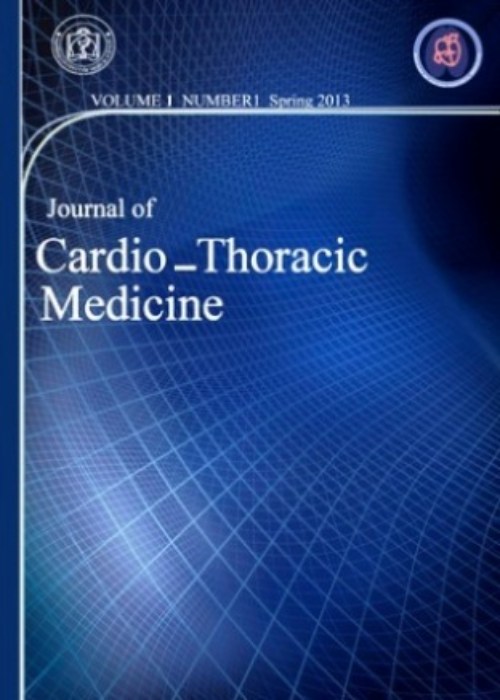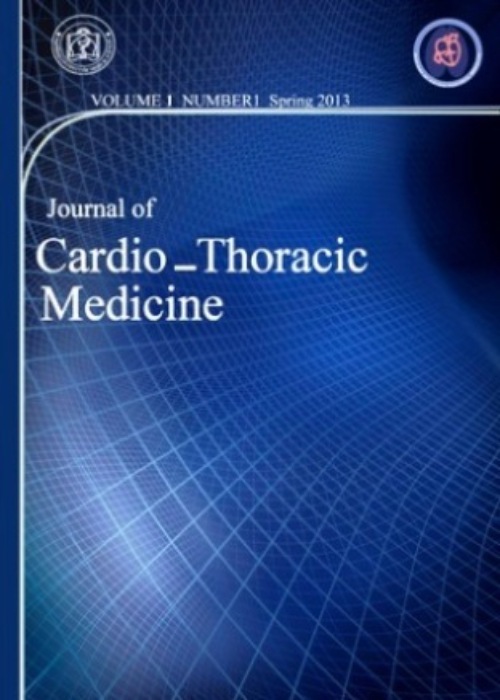فهرست مطالب

Journal of Cardio -Thoracic Medicine
Volume:11 Issue: 2, Spring 2023
- تاریخ انتشار: 1402/03/11
- تعداد عناوین: 7
-
-
Pages 1141-1150IntroductionRecent developments in echocardiography made assessing pulmonary arterial hypertension (PAH) in the heart, a suitable choice. This study aimed to investigate the association of myocardial right ventricular relaxation time and systolic pulmonary artery pressure (SPAP) in PAH patients.Materials and MethodsThe present study evaluated 74 patients with PAH (n=49) and age- and sex-matched healthy controls (n=25). All patients underwent transthoracic echocardiography. We evaluated the right ventricular (RV) function's echocardiographic parameters, including IVRT, IVCT, S, E, A, S’, E’, A’, ET, DT, TAPSE, FAC, and SPAP.ResultsWe found no significant differences in age and gender between the two studied groups (p>0.05). However, we observed a significant difference in IVRT, IVCT, E’, A’ (p=0.004), A, S’, DT, TAPSE, FAC and SPSP (p<0.001 for all cases) between two studied groups. Unlike the control group, we revealed a significant correlation between S’ and E’ (r=0.45, p=<0.001), S’ and A’ (r=0.66, p=<0.001), S’ and FAC (r=0.3, p=0.035), A and A’(r=0.4, p=0.004), TAPSE and FAC (r=0.82, p=<0.001), TAPSE and SPAP (r= -0.43, p=0.002), MPI and A (r= -0.35, p=0.013), MPI and ET (r= -0.72, p=<0.001), E/A and E/E’(r=0.47, p=<0.001), and BSA and S’ (r= -0.3, p=0.011). In addition, no meaningful association was found between SPAP and IVRT and IVCT (p>0.05).ConclusionOur findings revealed that IVRT and IVCT might not be affected by the SPAP and, therefore, could be used in the assessment of right ventricular function in patients with PAH.Keywords: Myocardial right ventricular relaxation time, pulmonary artery pressure, Pulmonary arterial hypertension
-
Pages 1151-1158Introduction
The Coronavirus Disease 2019 (COVID-19) outbreak is still an ongoing problem affecting people’s well-being globally. It is known that malnutrition is an important determinant of immune function, leading to an increased risk of infection and severity of diseases. The aim of this study was to characterize the relationship between macronutrients and micronutrients and this viral infection.
MethodsThis study was a historical cohort including 6539 subjects (57.2% females, 42.8% males) from the Mashhad stroke and heart atherosclerotic disorder (MASHAD) cohort study. Dietary intakes were assessed using a 65-item validated food frequency questionnaire (FFQ). Data on COVID-19 diagnosis was collected from online health records of patients available in the Sina health information system from the onset of the disease to the end of July 2020. COVID-19 diagnosis has been confirmed using a lung spiral CT scan or PCR laboratory test. SPSS software (Version 20) was usedfor the analysis of data. .
ResultsA total of 154 subjects including 85 men (55.2%) and women (44.8%) were infected with COVID-19. Body mass index (p=0.03) and waist circumference (p=0.01) of the patients along with the protein (p=0.02), total N2 (p=0.02), calcium (p=0.02) and thiamin (p=0.04) content of their diet was significantly associated with COVID-19. After multivariate analysis, dietary calcium remained the only dietary factor that predicted COVID-19 infection (OR=0.94, 95%CI [0.87-0.99], p value=0.04).
ConclusionOur findings indicated that prevalence of COVID-19 may be affected by dietary macronutrients and micronutrients. According to our data, increased calcium intake can reduce the prevalence of COVID-19.
Keywords: COVID-19, Dietary intake, dietary calcium, Malnutrition -
Pages 1159-1166Introduction
It has been shown that angioplasty and endovascular stent deployment, used after coronary revascularization, are associated with an inflammatory response. Inflammation has a key role in the complications of atherosclerotic plaque, coronary artery disease (CAD) and in-stent restenosis (ISR). The objectives of the present study was to investigate serum levels of 12 pro/anti-cytokines and growth factors and their relationship with restenosis.
MethodsA total of 244 subjects were recruited in current study including unrelated patients who previously underwent coronary stent implantation (between 2014 and 2017) and were subsequently indicated for coronary angiography. According to angiography results patients were allocated into two groups: cases with stenosis more than 50% within the stent (N=79) and controls with stenosis less than 50% within the stent (N=165). Serum was separated by centrifuging the blood for 15 min at 1000 rpm. Serum cytokines levels including IL-1α, IL-1β, IL-2, IL-4, IL-6, IL-8, IL-10, TNF-α, IFN-γ, MCP-1, EGF, and VEGF were measured using an EV 3513 cytokine biochip array (Randox Laboratories, Crumlin, UK).
ResultsThe mean age of the NISR and ISR groups were 62.47±9.2 and 59.49±8.48 years, respectively. The diabetes frequency was significantly higher in the ISR group (55.1%) compared with NISR group (30.9%) (p<0.001). There was no significant difference in levels of cytokines between the two groups (p>0.05).
ConclusionsThe results showed that serum levels of pro/anti-inflammatory cytokines and growth factors did not have a significant difference between NISR and ISR study groups.
Keywords: Inflammation, Cytokines, Growth factors, In-Stent Restenosis -
Pages 1167-1176Introduction
Studies have shown that patients with inflammatory bowel disease (IBD) have an increased risk for venous thromboembolism (VTE). VTEs causes significant morbidity and mortality.
MethodsWe carried out a comprehensive search through different online databases including PubMed, Google Scholar, Scopus, and Medline. We focused on some of patients-related factors that may affect the risk of VTE incidence among IBD patients and also reviewed current guidelines on the prophylactic regimen of the IBD patients.
ResultsBased on the previous studies, the hypercoagulable nature of the disease results from a complex interaction between the systems participating in the coagulation cascade, including endothelial cells, platelets, and coagulation factors. There are a number of clinical factors that increase the probability of VTE development which include disease activity, age, pregnancy, surgery, and medical treatment.
ConclusionTaken together, these data suggest to initiate prophylactic regimen in IBD patients and to adjust it regarding to the patient’s condition and the presence of other predisposing factors.
Keywords: Inflammatory bowel disease, Venous thromboembolism, Inflammation, Prevention -
Pages 1177-1183
Coronavirus disease 2019 (COVID-19) displays various clinical manifestations, and mounting evidence suggests that COVID-19 has extrapulmonary and cardiovascular involvement. Although cardiac effects are less prevalent in COVID-19 than pulmonary manifestations, understanding potential cardiac issues with COVID-19 is critical for risk stratification and improving outcomes. We report a male patient aged 56 years who presented with sudden onset of chest pain and dyspnea. The patient has a history of both hypertension and stroke. He has never traveled abroad or had previous contact with a COVID-19-positive patient. Physical examination demonstrates tachypnoea, desaturation, increased JVP, bronchial breath sounds, and rhonchi on the right basal lung. Inflammatory markers, liver function, and CKMB levels were all elevated in the laboratories. . Infiltrates and cardiomegaly were observed on a chest X-ray. Sinus tachycardia, irregular rhythm, and ST elevation on lead V1-V5 were detected on the electrocardiogram. Our patient was diagnosed with COVID-19 critical degree with STEMI and atrial fibrillation. Increased inflammatory cytokines caused by COVID-19 and a history of cardiovascular disease may play a crucial role in cardiac injury. The patient did not undergo reperfusion therapy, considering the late arrival to the hospital, and was managed with anticoagulant therapy. The patient responded well to therapy. After 15 days of treatment in an isolation room and two weeks in a non-isolation room, the patient exhibited clinical improvement and could be treated as an outpatient case. Patients with preexisting cardiovascular conditions are more likely to contract COVID-19, which significantly impacts the disease's course, treatment, and prognosis.
Keywords: COVID-19, ST elevated myocardial infarction, Atrial fibrillation -
Pages 1184-1187
Foreign body aspiration (FBA) remains a significant cause of morbidity and mortality, especially among young children. However, FBA is rare in adults, and it occurs in the settings of neurological impairment and altered consciousness. We herein present a rare occurrence; a middle age female who aspirated a straight metal pin while holding it in her mouth for her veiling. This is rare because, unlike most other cases, our patient had none of the conventional risk factors for FBA and the incidence took place in a normal mental state. In our case report the aspirated metal pin had placed in the terminal part of her left bronchus, while according to the literature, once a foreign body enters the respiratory tract, it is most likely that the object be placed in the right bronchus due to its straighter angle. The patient received the necessary imaging modalities and due to the complexity of her condition, she had to undergo thoracotomy. This adds to the rarity of our report since FBA patients usually suffice either flexible or rigid bronchoscopy.
Keywords: Aspiration, Bronchoscopy, Foreign body -
Pages 1188-1191
Infective endocarditis (IE) is lethal complications inspite of advanced antibiotics. Prosthetic valve endocarditis (PVE) complications are dehiscence, paravalvular leak, perivalvular abscess, heart failure, persistent fever, positive blood culture and presence of vegetation. Therefore, the diagnosis is confirmed by clinical findings, blood cultures, and echo data according to Duke’s criteria. Surgery in those cases are life-saving when indicated, despite it carries high risk mortality especially after stroke.
Keywords: iInfective endocarditis, prosthetic valve endocarditis, tissue mitral valve, transcatheter mitral valve replacement


